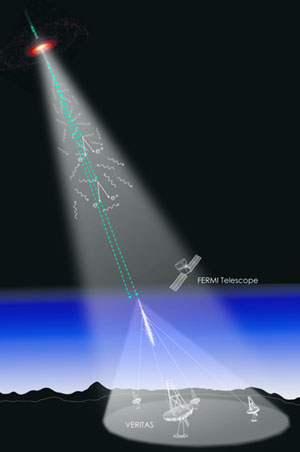Counts of gamma-ray photons from distant galaxies used to measure the Hubble constant
The Hubble constant sets the absolute scale and the age of the Universe. Observations of high-energy photons from distant galaxies tell us how fast our Universe is expanding. This is a new voice in a hot cosmological debate on discrepant measurements of the Hubble constant.

Precision of its determination has been limited for decades due to rather imprecise measurements of cosmological distances. However, recent unprecedented advances in observational cosmology yielded two extremely precise distance calibrations which changed completely this situation. The two ways of gauging cosmological distance scales are based on observations of the cosmic microwave background (CMB) radiation coming from the early evolution phase of the Universe and the cosmic distance ladder, which is the succession of methods to measure distances in our close vicinity (relative to cosmic scales). The two methods lead surprisingly to two different values of the Hubble constant. Our Universe as seen through the CMB turns out to be 9 per cent older than what observations in our local vicinity tell us. Both measurements are so precise that there is a 1:50000 chance that the discrepancy occurs as a statistical fluke.
Discrepant values of the Hubble constant may arise from unknown and yet unaccounted systematic effects in one or both measurements. Recognizing and correcting this kind of effects is arguably the most challenging task. Despite a great effort from many independent teams, none of potential systematic effects assessed so far seems to be large enough to explain the discrepant values of the Hubble constant. This makes many researchers to consider seriously the possibility that the Hubble constant tension may be a genuine cosmological anomaly: the first cosmological observation which cannot be explained by the current cosmological model. Various modifications of the standard cosmological model are being proposed as possible remedies for the Hubble constant problem. Each of them postulates a rather radical change in the commonly accepted cosmological paradigm (for example, a new form of dark energy in the early Universe), but none of them provides a complete solution to the problem. Moreover, can we be really sure that these new theoretical models try to explain something that may turn out to be a hidden systematic effect ? The stakes are high.
Probably the most promising way of checking where the problem is relies simply on measuring the Hubble constant using different data, observational techniques and methodologies for data analysis. The process of cross-checking many different results will eventually shed more light on the cause of the Hubble constant discrepancy. In the new study co-led by DARK researcher Radek Wojtak, the Hubble constant was derived from gamma-ray observations of distant galaxies, obtained with the Fermi Gamma-ray Space Telescope and ground-based Cherenkov telescopes. In this novel technique, cosmological distances are determined by means of measuring the loss of gamma-ray photons in radiation coming from extragalactic sources. The photon loss results directly from interactions between gamma-ray photons from the source and photons of extragalactic background light which convert a fraction of gamma-ray radiation into pairs of electrons and positrons. Further the gamma-ray source is, less gamma-ray photons we detect. This simple rule underlies the basic concept of calibrating cosmological distances with the new method.
The new value of the Hubble constant is more consistent with the value derived from the CMB rather than the cosmic distance ladder; however, the current uncertainty is too large to pin down the most troublesome measurement. Nevertheless, the researchers hope that future observations and further development of relevant models employed in data analysis will improve this result and help understand the reason behind the Hubble constant tension.
Link to Scientific article: A new measurements of the Hubble constant and matter content of the Universe using extragalactic background light gamma-ray attenuation
See also:
Contact
Radoslaw Jan Wojtak, Assistant professor
Dark Cosmology Centre
Email: radek.wojtak@nbi.ku.dk
